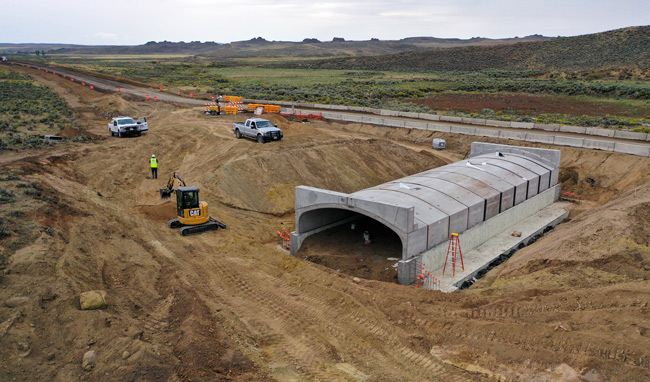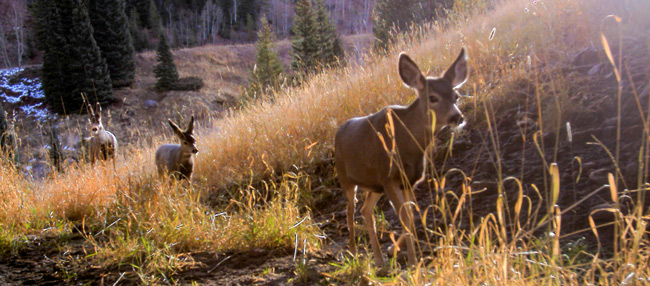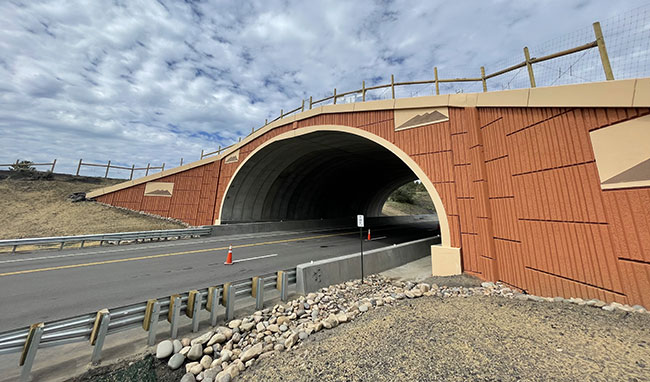Wildlife Migration and Movement
Page Content
Statewide Wildlife Crossing Map

View the location, details, and pictures of Colorado's existing highway crossing structures on the Colorado Wildlife Crossing Web Map that was developed in collaboration by Colorado Parks and Wildlife, and the Colorado Department of Transportation with coordination by ECO-resolutions.
Animals on the Move
Many big game species exhibit annual migrations by moving along traditional routes between seasonal ranges, often associated with plant phenology and weather. Colorado’s big game typically migrates from higher elevations in the summer to lower elevations as winter approaches; and migrate in the spring from winter range back to summer range, following the spring forage green-up. Animals also need the ability to move within seasonal ranges to maintain resiliency in response to habitat conditions and changing pressures on the landscape.
Colorado’s mountainous terrain creates winter ranges that are in closer proximity to summer ranges, which often leads to shorter dispersed migration pathways rather than long, narrow corridors. Longer routes can expose animals to greater risks than shorter routes, while shorter routes enable animals to conserve energy for the long winter ahead.
Barriers to Movement
Examples of barriers to movement include high-volume roadways, and housing or commercial development. Other activities disrupt wildlife movements such as various forms of recreation, low-volume traffic roads, and fencing that were not constructed to wildlife-friendly design guidelines. A number of these barriers are man-made changes to the landscape that are expected to increase as Colorado’s population continues to grow. It is also important to note that a single threat likely has multiple adverse impacts, and multiple threats are often compounded causing cumulative negative impacts to wildlife populations.
How Can CPW Help?
Colorado Parks and Wildlife with partner collaboration can take many actions to reduce barriers to wildlife movement. Wildlife crossing structures and wildlife radar detection systems can be installed on roadways to reduce wildlife-vehicle collisions while maintaining movement permeability. Removing degraded and old pasture or allotment fences, or modifying fences to follow wildlife-friendly fence designs can decrease the threat of fence entanglement. Timing stipulations and buffer zones can be applied to human activities to decrease disturbance to wildlife in areas of critical habitat.
Prioritizing Transportation Wildlife Infrastructure Projects
2019 & 2022
Featured Highway Mitigation Projects
Highway 13 North of Craig

Approximately 12 miles south of the Wyoming State line on State Highway 13, CDOT in partnership with CPW, has designed a unique project to aid in reducing wildlife vehicle collisions while maintaining permeability across the highway.
The project will use an 8' high wildlife exclusion fence to direct deer and elk to an arch underpass structure and two at-grade crossings with 4' low-fence segments to allow animals to cross the highway where driver sight distance is more favorable. These low-fence sections create a large animal crosswalk between segments of high-fence. At the northern low-fence segment a radar wildlife detection system will be installed to alert motorists of wildlife approaching or crossing the highway.
Due to land ownership concerns and large migratory elk herds numbering in the thousands, traditional wildlife crossing structures would be cost prohibitive at the necessary scale and frequency. These mitigation components, coupled with the reconstruction and widening efforts are anticipated to reduce wildlife vehicle collisions and provide more reaction time for drivers that encounter wildlife crossing the roadway. The anticipated completion date is late summer 2022.
I-25 South Gap

The I-25 South Gap project was needed to expand the only 2-lane portion of the highway (each direction) between Denver and Colorado Springs to 3-lanes. The project spans 18 miles of I-25 between Castle Rock and Monument and includes four large span bridges that are designed as dedicated wildlife underpases and one multi-use structure under the newly constructed six lane highway.
The structures were completed in fall 2021 and are connected by an 8’ high wildlife exclusion fence.CDOT is designing a wildlife overpass located south of Greenland, however construction funding has not been secured. CDOT and CPW partnered on a research project which started in Fall 2021 and continues at least until Fall 2024.The collaboration between CDOT and CPW was a shining example of how both agencies (with different missions) can work together for a mutually beneficial project. Listen to this podcast to learn more.
I-70 West Vail Pass

The project improvements include an eastbound and westbound auxiliary lane, reconstruction of tight curves, shoulder widening and six wildlife underpasses along with wildlife exclusion fence on I-70 on the west side of Vail Pass in Eagle County.
The wildlife underpasses consist of two large structures to pass large ungulates such as elk and deer, and four smaller structures designed for black bear, mountain lion and lynx. The structures are located in the top five miles of the pass and tie into existing large span bridges lower on I-70. The anticipated completion date for the underpasses and associated wildlife features is 2024.
Highway 160 West of Pagosa Springs

The main goal of the project was to construct new wildlife mitigation structures along a 2 mile stretch of Highway 160 west of Pagosa Springs to reduce wildlife-vehicle conflicts and maintain habitat connectivity. The project includes two large crossing structures, a wildlife underpass completed in 2021 and a wildlife overpass completed in 2022, as well as associated wildlife fence to guide animals to the crossings and associated escape ramps. Highway 160 bisects important deer and elk migration routes and winter range. Wildlife migrating from the high country each fall have to navigate across the highway to access winter range to the south, and then in the spring the animals make their way back across the highway to head north to higher elevation summer range. Whereas, some deer and elk winter along Highway 160 and make regular movements across the highway during the winter months. Wildlife-vehicle collisions made up more than 60 percent of crashes in the project area prior to the project completion. A multi-year study is planned to monitor the impact of the project on reducing wildlife-vehicle conflicts and maintaining wildlife movement permeability.
Highway 9 South of Kremmling
In 2016, five wildlife underpasses along with two overpasses were completed along a 10.5 mile stretch of State Highway 9 south of Kremmling. Wildlife exclusion fence spans the project area and guides animals to the crossings. CDOT and CPW co-funded a research project from November 2015 through April 2020, researchers documented over 112,000 mule deer successful crossings at the 7 crossing structures, along with elk, black bear, moose, pronghorn, bobcats and many other wildlife species. In addition, there was a 90% reduction in wildlife vehicle collisions carcasses documented during this timeframe. See how this mitigation project has succeeded in providing safe passages for wildlife while improving motorist safety.
Policy Actions
Colorado
2022
- Governor Polis signed SB22-151 Safe Crossing for Colorado Wildlife and Motorists Act on June 1, 2022. The bill creates the Colorado wildlife safe passages cash fund for use by the Colorado Department of Transportation (CDOT) to provide funding for projects that provide safe road crossings and connectivity for wildlife, and that increase motorist safety by reducing wildlife-vehicle collisions. CDOT must consult with CPW and the Colorado Wildlife and Transportation Alliance regarding the disbursement of the money.
2021
2020
2019
Colorado Governor Jared Polis signed Executive Order D-2019-011, Conserving Colorado’s Big Game Winter Range and Migration Corridors.
In November, the Colorado Parks and Wildlife Commission also adopted a resolution reaffirming the Governor’s Executive Order and supporting the federal funding opportunity.
CPW and CDOT signed a memorandum of understanding in 2019 for collaboration in mitigating wildlife-vehicle collisions, identifying priority big game highway crossings in the state, and participation in and support of the multi-stakeholder Colorado Wildlife-Transportation Alliance (CWTA).
The Colorado Legislature also showed support in advancing wildlife corridor conservation and habitat connectivity with the development of a bipartisan Colorado Habitat Connectivity Senate Joint Resolution 21-021 that unanimously passed through both chambers of the Legislature and was enacted in June 2019.
Federal
2021
- Infrastructure Investment and Jobs Act was signed in the fall of 2021 and includes a 5-year pilot program of $350 million to construct wildlife road crossings. These structures reconnect important habitat and allow animals to pass safely over or under roadways, avoiding traffic while also improving motorist safety. The legislation also makes projects to reduce wildife-vehicle collisions eligible for funding in other existing and new transportation programs.
2017 and 2018
- A pair of secretarial orders issued by the U.S. Department of Interior (DOI) directed federal land managers to work with states to protect big game species and their habitat within the region.
Related Resources

